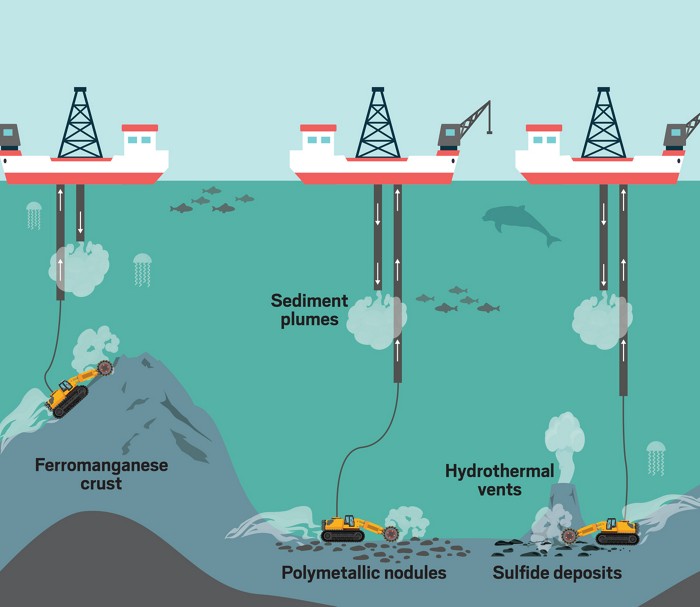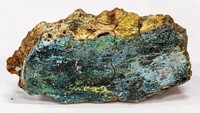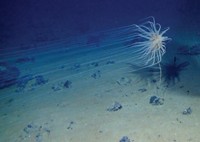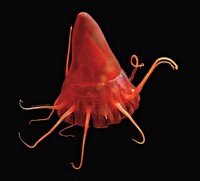Advertisement
Grab your lab coat. Let's get started
Welcome!
Welcome!
Create an account below to get 6 C&EN articles per month, receive newsletters and more - all free.
It seems this is your first time logging in online. Please enter the following information to continue.
As an ACS member you automatically get access to this site. All we need is few more details to create your reading experience.
Not you? Sign in with a different account.
Not you? Sign in with a different account.
ERROR 1
ERROR 1
ERROR 2
ERROR 2
ERROR 2
ERROR 2
ERROR 2
Password and Confirm password must match.
If you have an ACS member number, please enter it here so we can link this account to your membership. (optional)
ERROR 2
ACS values your privacy. By submitting your information, you are gaining access to C&EN and subscribing to our weekly newsletter. We use the information you provide to make your reading experience better, and we will never sell your data to third party members.
Water
The deep-sea mining dilemma
The seafloor is rich in minerals vital for a clean energy future, but extracting them could have long-lasting environmental impacts
by Priyanka Runwal
October 9, 2023
| A version of this story appeared in
Volume 101, Issue 33

Credit: Global Sea Mineral Resources | A nodule collection vehicle is ready to be launched from a mining ship.
In brief
The seabed is a potentially promising source of critical minerals that are in heavy demand for clean energy technologies. But retrieving those resources comes with long-term environmental consequences. Proponents argue that extracting minerals from the deep sea has fewer impacts on nature and human lives than land-based mining does. A handful of companies and state agencies have recently conducted exploratory tests with the aim of eventually commercializing these underwater reserves. But because we lack international regulations and knowledge of the full environmental effects, many countries are calling for a ban or pause on seabed mining. Whether the International Seabed Authority will allow such a moratorium remains to be seen, but some scientists think it’s only a matter of time until mining commences.
Nearly 150 years ago, scientists and sailors set out aboard the HMSChallenger to explore the world’s oceans. Hauling up a dredge it had dragged along the North Atlantic seafloor, the team found a number of peculiar rocks the size of potatoes. Black, bumpy, and surprisingly lightweight for their size, they were among the first so-called polymetallic nodules to be recovered from the deep sea.
Rich in manganese and iron oxides, such rocks can also contain smaller amounts of valuable metals, including copper, cobalt, and nickel, as well as traces of molybdenum and tellurium.
Nodule contents


At the time, the team didn’t recognize the commercial potential of these deep-sea mineral reserves. But in the past few decades, nodules have attracted significant mining interest. Proponents of deep-sea mining claim that these underwater deposits could help meet growing demand for critical minerals, particularly those needed for clean energy technologies such as electric vehicle batteries, wind turbines, and solar panels.
“We think nodules are quite marketable right now,” says Charles Morgan, a Hawaii-based environmental scientist who has consulted on exploratory seabed mining projects. “There’s real excitement about it; there’s a lot of investment going on.”
On land, mining cobalt and nickel, for example, typically requires slashing large areas of tropical forest and creating open pits to dig out the ore. Such destruction causes pollution, the loss of biodiversity, and the release of carbon stored in trees and soil, thereby contributing to climate change. Mining also harms the health and traditional livelihoods of people living nearby. Some mines are accused of human rights violations, including the use of child labor, in the case of Democratic Republic of Congo’s cobalt mines.
Gerard Barron, CEO of the Metals Company, which is at the forefront of the deep-sea mining rush, insists that getting such minerals from the deep ocean will be less environmentally damaging than extracting the land reserves. Retrieving critical minerals from the seabed could also skirt significant social damages.
But experts argue that deep-sea mining is unlikely to halt or reduce terrestrial mining. The process could also severely disturb the marine environment and eradicate unique biodiversity. “It will be a long-term impact,” Morgan says. “Anybody who says differently is not telling you the truth.”

Since 2001, the International Seabed Authority (ISA), an intergovernmental body in charge of regulating deep-sea mining in waters beyond national jurisdictions, has granted 31 exploratory licenses to private companies and governmental agencies. But the organization is unlikely to approve commercial mining applications until its 36-member council reaches consensus on rules regarding exploitation and the environment. Recent negotiations ended without an agreement, and member states set a 2025 timeline to revise and adopt the regulations.
Meanwhile, many scientists emphasize how little we know about the deep sea and the full environmental consequences of mining there. In a 2021 open letter, they asked for a moratorium on commercial seabed mining. Similarly, some countries, seafood industry groups, financial institutions, and various companies—including Google, Philips, Volvo, and BMW Group —have also called for a complete ban or precautionary pause on deep-sea mining until its impacts are clearer.
Small-scale experimental mining studies have revealed some answers, but many questions remain, says Travis Washburn, an ecologist who worked with the Geological Survey of Japan to study impacts of seabed mining tests. “We still have long ways to go,” he says.
How deep-sea minerals form
For mining purposes, companies are focusing on three types of marine mineral deposits. Of greatest interest are polymetallic nodules strewn across the ocean floor about 4,000 m down.
These lumps of rocks can range from the size of grapes to large potatoes. They form when manganese and iron dissolved in seawater precipitate onto small objects, such as shark teeth, shell remains, and rock fragments lying on the seabed. The metals come directly from the water column or from water circulating between grains of soft seabed mud.
Advertisement
Precipitates of manganese oxide and iron oxyhydroxide (FeOOH) accumulate layer by layer at extremely slow rates of 1–10 mm per million years. “It looks like tree rings,” says Andrea Koschinsky-Fritsche, a marine geochemist at Constructor University. During the accumulation process, the Mn-Fe compounds also attract and bind other important dissolved minerals, including nickel, cobalt, copper, and lithium.
Nodules occur in many ocean areas, and their mineral composition varies between regions. Nodules found in the Indian Ocean basin, for example, are highly enriched in nickel and copper. They also contain high levels of manganese and moderate amounts of cobalt and lithium. Nodules in the Peru Basin are especially rich in nickel and lithium and contain high levels of manganese.
But it’s the polymetallic nodule beds of the Clarion-Clipperton Zone in the northeast Pacific Ocean that are of most commercial interest. Spanning between Hawaii and Mexico, this region—roughly the size of Europe—has one of the highest nodule abundances and contains more nickel and cobalt than all terrestrial deposits combined, according to a 2020 report by scientists at the Geomar Helmholtz Center for Ocean Research Kiel.
Another vast mineral reserve comes in the form of crusts that develop on the rocky tops and flanks of underwater volcanic mountains called seamounts. These crusts—typically a few millimeters up to about 25 cm thick—are rich in iron, manganese, and cobalt. Like nodules, they’ve formed over millions of years. MnO2 and FeOOH precipitate on the rocky surfaces and bind valuable metals, including cobalt and tellurium. “You need seamounts that are steep enough so that no sediments accumulate on the flanks, giving the crusts a solid surface to grow on,” Koschinsky-Fritsche explains.
Some of the thickest and most valuable crusts occur in the central-west Pacific Ocean between Hawaii and the Mariana Islands at depths ranging between 800 and 2,500 m. Referred to as the Prime Crust Zone, this area contains four times as much cobalt and nine times as much tellurium as all known land deposits combined, according to the Geomar report.
A third type of mineral reserve is massive sulfide deposits that form as sulfide-enriched water spouts from tall, chimney-like seabed structures called hydrothermal vents. The process involves interactions between volcanic rocks beneath the ocean floor and heated seawater that dissolves metals and other elements present in the rocks. This hot, acidic fluid spews from hydrothermal vents, precipitating sulfide. The material settles on the seafloor and binds valuable metals, such as zinc, silver, lead, and copper.
As with nodules and crusts, companies can get several desired metals from one package. But extracting every additional metal “costs more money,” says James Hein, a marine geologist and former scientific adviser to the ISA’s US delegation.
Bringing up the minerals
The first step in retrieving these minerals involves sending a robotic collector vehicle to the seafloor. Tethered to a mining ship, this vehicle, equipped with cameras and strong lights, will travel a few hundred or even thousands of meters to reach the dark seabed. Over the past few decades, engineers have built a variety of prototypes that can vacuum, pluck, or cut and scrape these deep-sea deposits.
Mining minerals

To collect nodules, for example, Patania II, a bus-size prototype developed by Global Sea Mineral Resources, uses seawater to create high-pressure water jets that stir up seafloor sediment and dislodge the nodules. Suction machines vacuum the nuggets along with scattered mud, which is then separated and released back into the sea. The Metals Company used a similar machine as part of its test run last year, during which it collected nearly 3,000 metric tons of nodules from the Clarion-Clipperton Zone.
Extracting crusts and sulfide deposits calls for other types of mining equipment. These deposits are difficult to remove because the crusts stick to the steep and uneven rock surfaces on which they grow, Koschinsky-Fritsche says. Collecting too much rock while mining the crust dilutes the deposit, she adds. Engineers have designed remotely operated vehicles that first peel off the crust and then cut and crush it into roughly paper clip–size fragments. Researchers based in China developed such a prototype and have been testing it to retrieve minerals from crust-coated seamount slopes in the South China Sea.

The same cut-and-crush principle also applies to mining massive sulfide deposits. Nautilus Minerals, a now-bankrupt deep-sea exploration and mining company, had plans to use its remotely controlled vehicle to cut and crush mound-shaped sulfide accumulations at a 1,600 m depth off the coast of Papua New Guinea. The next steps would be to gather this material, pump it to the mining ship, and transport it offshore for further processing.
Japan, on the other hand, successfully tested its prototype in Okinawa’s waters and gathered large quantities of sulfide ore in 2017.
“The technology is there now,” Morgan says. “The big problems are regulatory and environmental.”
Measuring mining’s impact

The greatest impacts of seabed mining will likely come from destroying underwater habitats and permanently removing hard surfaces. On the soft, muddy seafloor, such hard substrates are scarce, and species such as sponges, sea anemones, and xenophyophores rely on nodules to anchor themselves. In a recent modeling study, researchers showed that removing nodules could result in the disappearance of many sponges as well as creatures such as crabs, clams, and small worms that depend on these sessile species (Sci. Rep. 2021, DOI: 10.1038/s41598-021-91703-4).
Mining also generates clouds of sediment that can harm ocean critters. These underwater plumes form when mining vehicles rake the seabed or when unwanted sediment and seawater are discharged from mining ships after separating the ore. As this silt makes its way back to the seafloor, it can smother ocean life. The suspended sediment can also clog filtering organs that animals such as corals and sponges rely on to strain their food from water.
In one study of the effects of seabed mining, scientists estimated that a single nodule-mining operation could produce 30,000–80,000 m3 of sediment every day, enough to fill about 4,000–10,000 dump trucks (Mar. Policy 2022, DOI: 10.1016/j.marpol.2022.105006). “If this sediment comes by a few times, or once, the animals may be able to clean themselves,” says Matthias Haeckel, a marine biogeochemist at the Geomar center and a coauthor of the study. “But if it comes often, it creates stress, and we don’t know if they’ll be able to deal with that.”

The impacts may be local and extend just a few kilometers beyond the mining site as the plume spreads and the sediment settles. But the damages will be long term, Haeckel adds.
As part of a project called MiningImpact, Haeckel and other scientists observed prolonged effects of experimental mining in the Clarion-Clipperton Zone and the Peru Basin. They revisited sites where nodules and the top mud layer had been removed just a few months earlier and nearly 40 years ago. Even after about 4 decades, these sites—anywhere from one-fifth the size of a US football field to about 2,000 football fields—largely lacked sessile creatures and the mobile animals that depend on them.
Also, the microbial activity in these disturbed sites was reduced substantially compared with undisturbed areas nearby. Haeckel says, “That was something we had not expected, that even the microbes have not adapted over decades to this disturbance.” But it’s understandable, he adds. “You’ve taken away the surface layer where all the microorganisms live.”
In the 2022 study, Haeckel and coworkers predicted that it would take hundreds of thousands of years for the sediment layer to rebuild and millions of years for nodules to regrow. It’s worrying, Haeckel says. “We should think a bit harder as a society if we really want to engage in deep-sea mining.”
That’s especially true when scientists still know very little about the deep sea and the creatures that live there. Recently, a team led by researchers at the Natural History Museum in London identified 5,000 new animal species from an untouched area of the Clarion-Clipperton Zone (Curr. Biol. 2023, DOI: 10.1016/j.cub.2023.04.052). “And there’s millions, possibly tens of millions of species in the deep sea still to be described,” Washburn says. Without knowing what’s down there, scientists can’t understand mining’s full impact, he adds.

Also, most studies so far have looked at relatively small-scale disturbances and measured effects over a few years to decades. Commercial mining, on the other hand, will span much larger areas and create noise and light pollution. How environmental consequences will scale remains unknown. “Until we actually do it, we’re not going to have all the answers,” Washburn says.
To mine or not to mine
Amid the unknowns and uncertainties, more than 700 scientists and policy experts, over a dozen countries, many environmental nonprofits, and several technology and auto giants have called for a ban or pause on deep-sea mining. Some finance and mining industry experts argue that retrieving minerals from the deep sea and restoring the disturbed landscape will be so expensive that mining doesn’t make financial sense, especially when nickel and cobalt reserves on land are sufficient to meet the global demand for decades.
But proponents claim that deep-sea mining will be less environmentally damaging than land-based extraction. In media interviews, the Metals Company’s Barron, for example, has said that retrieving critical minerals from the ocean will harm nature less than mining in places such as forests in Indonesia.
So far, no companies or state agencies have submitted commercial deep-sea mining applications to the ISA. But the Metals Company recently announced its plans to file an application next year to start exploiting nodules in an area of the Clarion-Clipperton Zone by 2025.
The ISA’s Legal and Technical Commission will have no choice but to consider the company’s application even if the official regulations, called the Mining Code, aren’t yet in place. The commission can make a recommendation to the council to approve or reject the application or indicate that it’s not able to offer a recommendation. In that last case, the application is rejected by default “unless there is sufficient majority at the council to overturn the decision,” says Pradeep Singh, an ocean governance expert at the Helmholtz Center Potsdam. Without this Mining Code, “the predominant view now is that perhaps an application should be by default rejected unless the council decides to approve it by the 60% majority,” he adds.
Any approval at this stage will be problematic because the ISA has still not defined thresholds for acceptable environmental harm and rules for equitably sharing profits from mining in international waters. “I’m not holding my breath that the regulations will be done soon,” Washburn says.
Meanwhile, Morgan thinks that despite the environmental concerns, an international deep-sea mining moratorium won’t work. Mining companies have spent millions of dollars on research, infrastructure, and exploratory tests, and they’re going to push to make back that money, he says. “Investors are only going to go along with it for so long.”
Singh feels otherwise. “I don’t think it would be commercially viable at this point in time,” he argues. “I wouldn’t take it for granted that it will and must happen.”





Join the conversation
Contact the reporter
Submit a Letter to the Editor for publication
Engage with us on Twitter